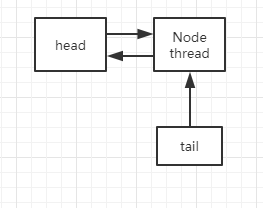AQS(AbstractQueuedSynchronizer, 队列同步器)它是Java并发用来构建锁和其他同步组件的基础框架。像Reentrantlock,Countdownlantch,Semaphore,ReadWriteLock都是由AQS来实现的,本篇文章将通过分析ReentrantLock源码来解释AQS
先看一段代码:
package com.example.AQS;
import java.util.concurrent.locks.Lock;
import java.util.concurrent.locks.ReentrantLock;
public class ReentrantlockTest {
/**
* 资源类
*/
private static class Resource{
Lock lock = new ReentrantLock();
public void getResource(){
//加锁
lock.lock();
//睡眠两秒钟代表业务逻辑
try {
Thread.sleep(2000);
} catch (InterruptedException e) {
e.printStackTrace();
}
System.out.println("got resource");
//解锁
lock.unlock();
}
}
public static void main(String[] args) {
Resource resource = new Resource();
//五个线程竞争资源
for (int i = 0; i < 5; i++) {
new Thread(()->{
resource.getResource();
}).start();
}
}
}

程序执行结果是每隔两秒打印获取到资源,说明存在锁竞争
我们从头来分析一下代码,首先看new ReentrantLock(),
public ReentrantLock() {
//默认是非公平锁
sync = new NonfairSync();
}
我们可以在新建锁资源时选择公平锁还是非公平锁,至于两种锁的区别我们后续讲解
public ReentrantLock(boolean fair) {
//传入true为公平,false为非公平
sync = fair ? new FairSync() : new NonfairSync();
}
看完构造方法来看下加锁方法,lock.lock()
public void lock() {
sync.lock();
}
ReentrantLock里面主要使用了其内部类Sync。Sync则是AbstractQueuedSynchronizer的实现类,也就是AQS的实现类。

通过继承关系我们看到公平锁和非公平锁都是Sync的子类。lock方法是一个抽象方法,我们先分析FairSync公平锁的实现。
final void lock() {
acquire(1);
}
public final void acquire(int arg) { //arg=1
if (!tryAcquire(arg) &&
acquireQueued(addWaiter(Node.EXCLUSIVE), arg))
selfInterrupt();
}
这个判断语句逻辑很复杂,当进入到acquire方法后,会尝试获取锁,当获取失败,返回false,会进入acquireQueued方法,不妨剧透一下,这个方法就是对获取锁失败的线程进行排队。我们先来看tryacquire方法的实现。
protected final boolean tryAcquire(int acquires) { //acquires=1
final Thread current = Thread.currentThread();
//c就是状态标识,如果c为0,说明能够尝试获取锁
int c = getState();
if (c == 0) {
//hasQueuedPredecessors返回false才能进行占有锁的动作,hasQueuedPredecessors主要作用是判断队列中有没有等待的线程。有返回true,没有返回false
//compareAndSetState是进行锁的占有动作,将c改为acquire的值
if (!hasQueuedPredecessors() &&
compareAndSetState(0, acquires)) {
//setExclusiveOwnerThread设置当前锁占有的线程为当前线程
setExclusiveOwnerThread(current);
//都设置成功代表占有锁成功,返回true
return true;
}
}
//当前线程为锁正在被占有的线程,即锁的冲入过程
else if (current == getExclusiveOwnerThread()) {
//对c进行+1
int nextc = c + acquires;
if (nextc < 0) //超过最大值抛异常
throw new Error("Maximum lock count exceeded");
setState(nextc); //设置state的值
return true;
}
//获取锁失败,返回false
return false;
}
分析下if判断中的hasQueuedPredecessors方法:
//方法的主要作用就是判断有没有等待中的线程
public final boolean hasQueuedPredecessors() {
Node t = tail; //队列的尾
Node h = head; //队列的头
Node s;
//如果头尾都为空,返回false,如果不为空,但是头的next不为空,说明有等待的线程,至于头和尾我们后续再说明
return h != t &&
((s = h.next) == null || s.thread != Thread.currentThread());
}
这样我们的tryacquire(1)方法就分析完了,我们再来分析acquireQueued(addWaiter(Node.EXCLUSIVE), arg))方法,只有获取锁失败了,才会进入此方法
先来看addWaiter方法
private Node addWaiter(Node mode) {
//封装当前线程为Node对象,方便对链表数据结构的操作
Node node = new Node(Thread.currentThread(), mode);
//得到队尾
Node pred = tail;
if (pred != null) { //当队尾不为空,说明前面有等待线程或者说明队列已经被初始化完成了
node.prev = pred; //将node的prev设置为队尾
if (compareAndSetTail(pred, node)) { //再将node通过cas设置成队尾
pred.next = node; //双向链表,设置原tail的next为node
return node;
}
}
//到这里说明队列还没进行初始化,这个方法就是初始化方法
enq(node);
return node;
}
来分析enq方法:
private Node enq(final Node node) {
//无限循环
for (;;) {
Node t = tail;
if (t == null) { //如果队尾为空
if (compareAndSetHead(new Node())) //通过cas将tail替换为new Node(),node里面的thread为空,这里设置线程为空的节点非常重要。
tail = head; //将head也指向这个节点
} else {
node.prev = t; //队尾不为空
if (compareAndSetTail(t, node)) { 将node插到队尾
t.next = node; //设置head的next
return t;
}
}
}
}
第一个线程获取锁失败后:

到这里addWriter方法就解析完了。接着看acquireQueued方法
final boolean acquireQueued(final Node node, int arg) {
boolean failed = true;
try {
boolean interrupted = false;
//死循环
for (;;) {
//找到当前node的前置节点
final Node p = node.predecessor();
//当前置节点为head节点并且获取锁成功后,说明已经占有锁
if (p == head && tryAcquire(arg)) {
setHead(node); //设置head为当前节点,这里面主要讲node的thread设置为空,恢复成原来的head的样子
p.next = null; // 将原来的头节点指向空
failed = false; //失败标识
return interrupted;
}
//走到这里说明没有获取成功,应该讲该线程park掉,shouldParkAfterFailedAcquire这个方法是判断前面的节点ws标识是不是0,如果是0就将它改成-1,返回true。parkAndCheckInterrupt就是当前线程park掉
if (shouldParkAfterFailedAcquire(p, node) &&
parkAndCheckInterrupt())
interrupted = true;
}
} finally {
if (failed)
cancelAcquire(node);
}
}
private final boolean parkAndCheckInterrupt() {
//park当前线程
LockSupport.park(this);
return Thread.interrupted();
}
到这里lock方法基本解析完成,接下来看unlock方法
public void unlock() {
sync.release(1);
}
看Sync类的release方法
public final boolean release(int arg) {
//tryRelease方法尝试释放资源,释放成功的话进入下面逻辑
if (tryRelease(arg)) {
//head节点
Node h = head;
//h不为空,并且h的waitStatus 不为0,说明当前有线程在排对获取资源
if (h != null && h.waitStatus != 0)
//取到该线程并且将其unpark
unparkSuccessor(h);
return true;
}
return false;
}
我们主要阅读tryRelease和unparkSuccessor方法
protected final boolean tryRelease(int releases) {
//将原来状态-1
int c = getState() - releases;
if (Thread.currentThread() != getExclusiveOwnerThread())
throw new IllegalMonitorStateException();
boolean free = false;
//已经没有线程占有锁,可以返回true,这里主要是考虑重入锁的情况,因此只能-1,不能直接赋值0
if (c == 0) {
free = true;
setExclusiveOwnerThread(null); //将资源拥有者改为空
}
//设置状态
setState(c);
return free;
}
再来看unparkSuccessor方法
private void unparkSuccessor(Node node) {
//得到当前node的状态
int ws = node.waitStatus;
if (ws < 0) //如果小于1说明后面有线程等待,将其改为0
compareAndSetWaitStatus(node, ws, 0);
//当前传过来的node为head,得到head的next才是真正要进行释放的节点
Node s = node.next;
if (s == null || s.waitStatus > 0) { //s为空的情况,这里基本不会发生,除非人为更改node
s = null;
for (Node t = tail; t != null && t != node; t = t.prev) //找到最近的能释放的线程节点
if (t.waitStatus <= 0)
s = t;
}
if (s != null)
LockSupport.unpark(s.thread); //unpark此线程
}
到这里锁的释放完成,代码回到上锁的park处。然后再次回到循环,获取锁。
至于interrupted主要是为lockInterruptibly方法准备的,在这里基本没用,因为无论返回什么都要进行下一次循环,这也是使用lock.lock(),不能在其他线程对其进行interrupt,但不能打断的原因。
再来看下非公平锁的实现
final void lock() {
if (compareAndSetState(0, 1))
setExclusiveOwnerThread(Thread.currentThread());
else
acquire(1);
}
发现只是在最开始尝试获取一下锁,如果没有获取到就按公平锁进行排队了。两者也只是这点区别。
































 被折叠的 条评论
为什么被折叠?
被折叠的 条评论
为什么被折叠?








